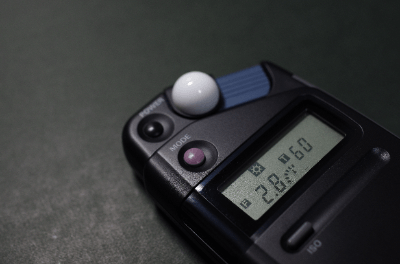What Is a Light Meter?

An exposure meter is a device used in photography to measure the intensity of light on a subject or in the environment and to calculate the optimal exposure value.
The measurement made with this machine is called light metering. Light meters are installed in most cameras today to determine the best exposure for a given photo.
Stand-alone products continue to be produced and sold, and the advantage of using an exposure meter is that it can measure light with high accuracy, regardless of the reflectance (brightness, color, etc.) of the subject.
Uses of Light Meters
Light meters are used either built into the camera or as stand-alone instruments to calculate the exposure value of a picture to ensure that the picture is taken with the correct exposure.
Light meters are useful not only for professional photographers but also for amateur photographers. For example, when taking landscape or portrait photographs, light meters are used to adjust the brightness of the subject and the background.
Light meters are also useful when the subject has strong contrasts. For example, when the subject is exposed directly to sunlight or when dark and bright areas are in the picture at the same time. Using a light meter allows the photographer to adjust the exposure so as not to cause white-outs or blackouts.
Furthermore, a light meter is also useful when using a flash. When using a flash, it is important to use the light meter to adjust the brightness of the flash. If the brightness of the flash is too strong, the subject will be blown out, so the appropriate brightness must be set.
Principle of the Light Meters
The principles of exposure meters are classified into two types according to the light metering method.
1. Reflected-Light Type
The reflected-light type, which detects the light reflected from the subject and determines the optimum exposure, is the type built into many cameras. With a reflected-light type exposure meter, all subjects are considered to be 18% reflective gray, and the exposure value is determined by calculating the intensity of the light reflected from the subject.
While this has the advantage of metering from the shooting position, it has the disadvantage of not being able to determine the exposure properly for extremely reflective or low reflective subjects such as white or black that are far from the 18% reflectance gray as the standard.
In addition, the camera’s built-in light meter allows the photographer to set the range over which metering is performed.
- Spot Metering
Measures the amount of light from a specific part of the subject and determines the exposure based on that part. - Center Metering
Measures the amount of light from the entire subject and determines the exposure based on the average value.
- Multi-Pattern Metering
Light from the entire subject is measured, and exposure is determined based on that information in multiple areas.
2. Incident Light Metering
The incident light method, often used in stand-alone cameras, determines exposure based on the light itself that enters the exposure meter. Since exposure is determined based on absolute light intensity rather than reflected light, it is not affected by the color of the subject and has the advantage of allowing the photographer to take pictures exactly as seen by the eye.
However, because it requires metering at the location of the subject, in principle it cannot be built into the camera.
How to Select a Light Meter
When choosing a light meter, it is important to consider the following points:
1. Subject to Be Photographed
If it is difficult to measure light close to the subject, such as in landscapes, choose a reflected-light exposure meter. If it is possible to measure light close to the subject, as in portrait or product photography, an incident-light type exposure meter is the best choice.
If both cases are possible, an exposure meter that can measure both reflected and incident light is recommended.
2. Display Type
Light meters that display digitally are often equipped with a wide range of functions. However, because of the abundance of functions, knowledge of time and photography is required to master the use of this type of meter.
Analog-type light meters, which display the result of a measurement at the position indicated by the needle, have simple functions, so even beginners can quickly master their use.
3. Battery Type
Light meters are not used for long periods of time, so the batteries do not need to be changed or recharged frequently. However, if you neglect to check the remaining battery level, the batteries may run out at the shooting site. In such cases, the type of batteries easily available at convenience stores can be used to take care of the situation immediately.